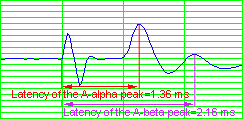|
Compound Action Potential |
Conduction velocity>
A-alpha and A-beta fibres |
| |
The objective of this part of the lab is to measure the
conduction velocity of the A-beta group of fibres in the nerve, using the absolute method. |
|
|
|
|
|
|
|
Up until now, we have only activated fibres
in the A-alpha group, the largest group of fibres in the nerve, containing
fibres with the
largest diameters and highest conduction velocity. This is because we have not used
stimuli strong enough to activate other groups of smaller, slower
fibres, which are less
excitable. With the frog sciatic nerve preparation, it is possible to observe the activity
of one other group of fibres, called the A-beta group. The activity of other, still
slower fibres is difficult to observe in a short length of nerve with the biphasic
recording technique. |
|
|
|
Procedure: using
the absolute method |
|
|
The stimulus duration is set to 0.2 ms
and the recording leads are connected to electrodes 1 and 2.
|
|
A maximal CAP is elicited, as before. This is the
A-alpha response of the nerve. Now increasing the stimulus voltage
gradually, we
observe a secondary wave, quite small, which appears in the response. The stimulus
voltage is increased until the size of the secondary wave no longer increases. This
secondary wave results from activation of A-beta fibres. |
|
Recall from the previous page that the
distance from the stimulating electrode to electrode 1 is 30 mm. |

|
|
Calculation: Using the sample latency and distance values
given above, compare the conduction velocities of A-alpha and A-beta fibres using the
absolute method formula.
Answer:
The conduction velocity for the A-beta fibres is 13.9 mm/ms, compared to the 22.1
mm/ms conduction velocity of the A-alpha fibres. |
|
|
|
|
Q: If we
increased the distance between stimulating and recording electrodes, allowing the CAP to
travel over a greater distance before recording, how would this change the displayed
response? A: The
temporal separation of the A-alpha and
A-beta elevations will increase as the conduction distance increases. That is, the
A-alpha and A-beta peaks will become more clearly separated in time. |
|
Consider the "runner analogy":
if an Olympic athlete and your humble self both leave the starting point at 0 time, a
fraction of a second later, you will still both appear to be right next to each other;
however, as the race continues, and more distance is covered, the difference in your
velocities will become more and more apparent. |
 |
|
Click here to continue with the topic of
Refractory Period |